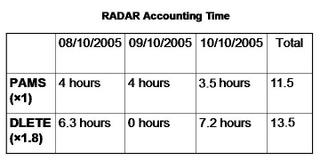Another early start today, but probably my last. I am inclined towards cancelling my last PAMS run tomorrow, I'd rather keep 12 hours in reserve. Plus I don't want to use all of the UK time on my experiments when there is still the tiny possibility of running the optics.
Things started quietly this morning. No D-layer to speak of, though I think that a few hours earlier had been better. Most activity seems to be occuring further poleward, including some ULF signatures. It improved here at about 6:15 UT when some strong precipitation occurred. Unfortunately this coincided with a large crowbar (the fourth of the morning) that took the radar offline for almost 5 minutes - a great shame. Anyway, things continue to look good for the moment.

It is my intention to swap to DLETE at 8 UT today, unless Mike has other ideas. A breakdown of my time so far (and projected) is shown. Since I am working on a 1.8 multiplication for DLETE I hope that EISCAT does not round up my usage, that is a vital half hour :-)
I spent a good portion of yesterday asleep so no proper data analysis has been done yet. The first day still looks the best though. Andrew and I did go to the ARIES site yesterday evening in an attempt to fix some more guy wires. However, we noted that those that we did manage to do last week had no tension. When an attempt was made to remove the slack via the rusty looking thingames (yes, that is a technical term) at the bottom of the wire, it would not budge - even with a squirt of faux-WD40. Andrew taped up his (rapidly disintegrating) knots to try and hold it in place and then we left. We would have stayed longer except that a driving wind had come up, it was getting dark and we were drenched in the rain! Perhaps we will try again today, but we feel that we are making zero progress. The good news is that the actual antenna poles and the dipoles look to be in very good order.
UPDATE: I notice that all data from SEC at NOAA seems to be stuck on two days ago. This means no current geostationary data and I am relying on SOHO for my solar wind data. Mike Rietveld has fixed the Dynasonde, however.
UPDATE2: D'oh! I mixed my hours up. Today should only have been 3.5 for PAMS since we started DLETEing at 8 UT. This has been corrected.
UPDATE3: More D'oh! Due to exciting results, and in pursuit of science, the DLETE run for today was extended to ~13:30 UT. This means that my little chart is completely wrong and so I shall post another in the next day or so.

